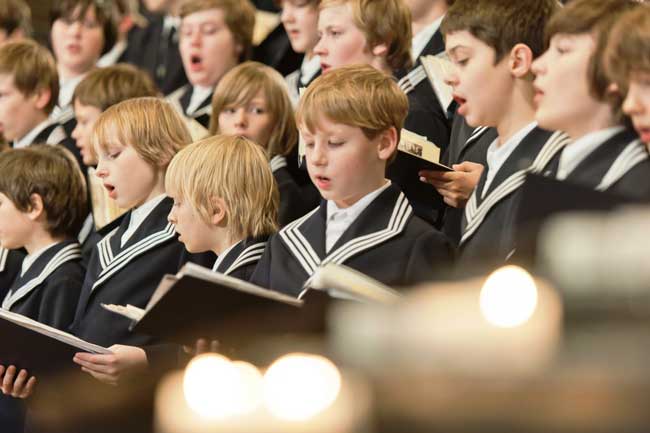
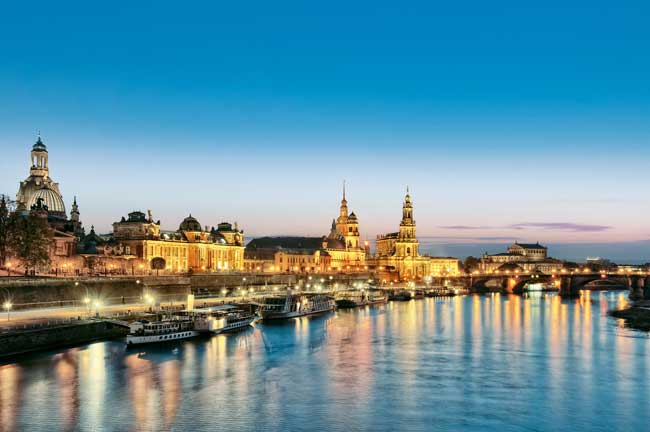
There’s a special allure to the German state of Saxony, located along the border of the Czech Republic and Poland.
The Elbe River meanders its length through hilly, even mountainous landscapes, such as “The Saxon Switzerland,” offering panoramic vistas and a thousand peaks for climbing.
Travel in Saxony
Saxony is also rich in history. So powerful and influential were its rulers they played an essential role in advancing the Reformation, protecting Martin Luther and crusading for his theological reforms.
Those rulers were also wealthy, their coffers enriched by the silver and other minerals in the Erzgebirge, or “Ore Mountains.”
Most notably, the rulers used that wealth to advance the arts, for centuries making their region one of the cultural hotbeds of Europe.
That vibrant arts scene exists even into the present day, and I had the good fortune to take a tour throughout Saxony with a special focus on arts and culture. Here are a few of the treasures I discovered.
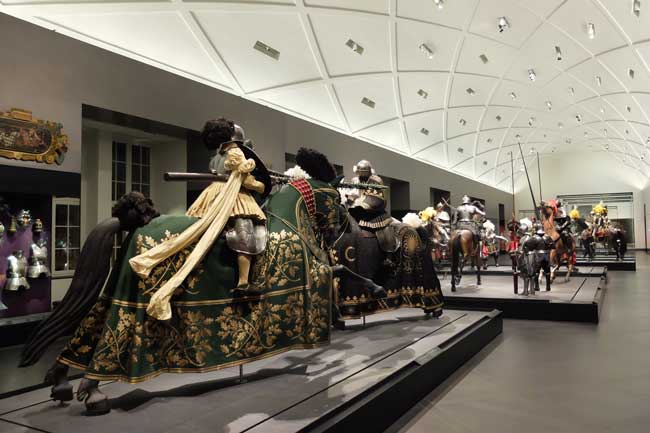
Visiting Dresden
Anyone who’s seen the skyline of Dresden will never forget the splendor of this Baroque jewel box of a city. It seems inconceivable that it was all a pile of rubble after the infamous firebombing in the waning days of World War II.
Now meticulously restored to their original grandeur, the buildings in central Dresden are an architectural triumph that will delight you at every turn.
For an overview, start with the “Procession of Princes,” a mural a full football field’s length painted on the exterior of the Royal Palace. Marching in single file, the rulers of Saxony parade one after another.
Many of them had colorful names, like George the Bearded and William the One-Eyed, but the most illustrious is Augustus the Strong, a powerful ruler whose physical strength was also legendary.
It’s said he could break horseshoes with his bare hands. It was Augustus who went on a building spree during his rule from 1694 to 1733, creating the masterpieces that caused Dresden to become known as “The Florence on the Elbe.”
The Church of Our Lady
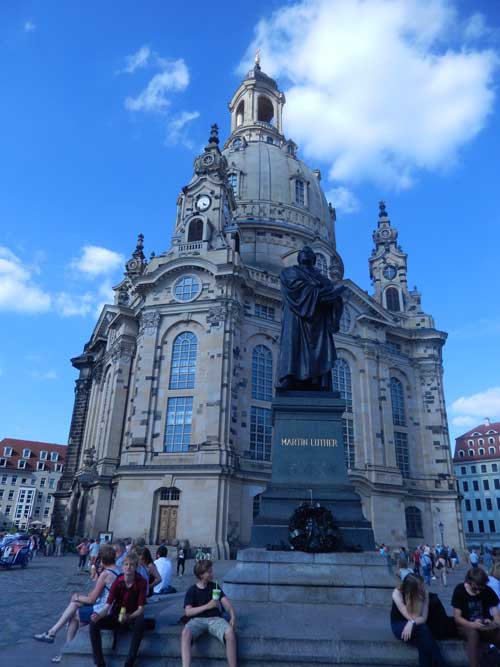
Towering above all the other buildings is the renowned Frauenkirche, the Church of Our Lady.
At more than 300 feet in height, the church’s dome is the largest in Europe north of the Alps.
It survived the 1945 bombing but collapsed two days later into a giant pile of stones that was left for decades as a peace memorial.
Between 1994 and 2005, the beloved church was reconstructed with the donations of tens of thousands of people worldwide.
It’s easy to see the mosaic effect on the church’s exterior made by the original, darker stones intermixed with the new, lighter ones.
And though it’s still a working Lutheran church, the Frauenkirche is also a place where 130 choral and organ concerts take place each year.
A tour of its interior will leave you marveling at the towering altar topped by a golden sunburst and huge silver organ pipes.
Those who don’t mind a physical challenge should climb to the viewing platform high atop the dome.
The View of Dresden
On a clear day, the reward for your efforts is a view of Dresden at your feet and the mountains of the Saxon Switzerland in the distance.
Plan to spend at least a full day at the adjacent Royal Palace, a complex of structures retaining a High Renaissance appearance. It’s what’s inside that will knock you over.
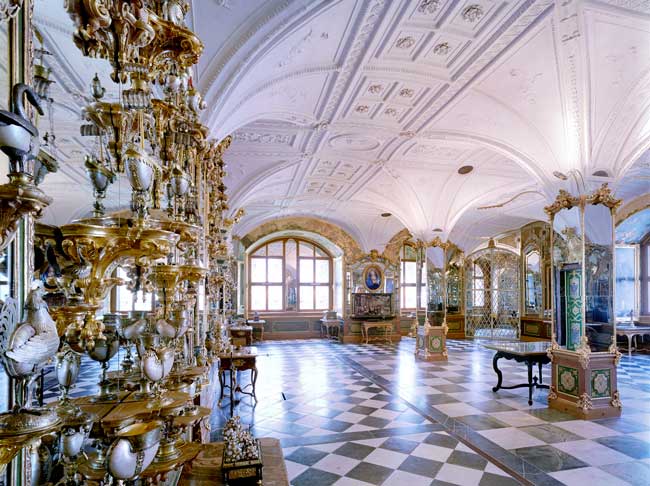
Several museums of the Saxon State Art Collection are housed in the palace, including the Museum of Prints, Drawings, and Photographs; the Coin Cabinet; the Armory; the Turkish Chamber; and the breathtaking “Grünes Gewölbe” (Green Vault).
Another is “Neues Grünes Gewölbe” (New Green Vault), which contain thousands of dazzling treasures, including the 41-carat Green Diamond, a huge frigate carved in ivory held aloft by the sea god Neptune.
The miniature Throne of the Grand Mogul Aurengzeb with more than 5,000 diamonds and dozens of rubies and emeralds.
The Armory
The Armory is similarly spectacular with displays of armored-clad knights atop armored-clad horses, a veritable forest of pikes, and whole constellations of daggers and swords artfully arranged to dazzle the eye.
There’s even a line of swirling knights complete with plumed helmets and velvet pantaloons engaging in sword play.
The Zwinger
Outside the Royal Palace is the Zwinger, an enormous terraced courtyard flanked by ornate, symmetrical buildings with lines of statuary atop them.
Picture members of the Saxon court parading through this outdoor space in their finery, then pop inside the buildings for two more museums of the Saxon State Art Collection.
One focusing on porcelain and another containing the Old Masters Gallery with Raphael’s famous Sistine Madonna (with its equally famous cherubs playing peek-a-boo).
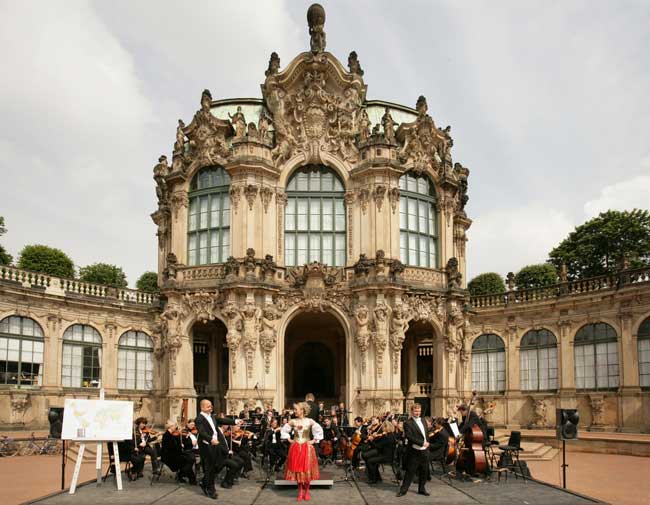
To top off your visit to Dresden, take one of the paddle-wheel steam boats down the Elbe to Pillnitz Palace, where the Countess Cosel, Augustus’s mistress, held sway in an elaborate complex of buildings with Oriental motifs, including rooftop pagodas.
The State Museum of Decorative Arts
Yet another museum, the State Museum of Decorative Arts, can be seen here, but it will be the horticultural arts found in the extensive gardens that will most enthrall you.
Don’t miss the huge 250-year old camellia. As winter approaches, it’s housed indoors inside a building that is transported to it, not the other way around.

Follow the Music Trail in Leipzig
Leipzig, the other big city in Saxony, has for centuries been an important trade and publishing center. It’s also a city where music has always called the tune.
More than 500 composers have made their home here, including some of the biggest names in music history, like Johann Sebastian Bach, Felix Mendelssohn, Robert Schumann, and Richard Wagner, all of whom both composed their works and resided at various sites around the city.
To make it easy for visitors, Leipzig has put together a 5-kilometer-long Music Trail connecting the most important sites. The sites associated with Bach are especially impressive.
From 1723 until his death in 1750, Bach served as choirmaster of St. Thomas Church, an 800-year-old Gothic church not far from the city’s Market Square.
He directed the centuries-old St. Thomas Boys Choir, still in existence today and performing regularly during church services and weekly concerts.
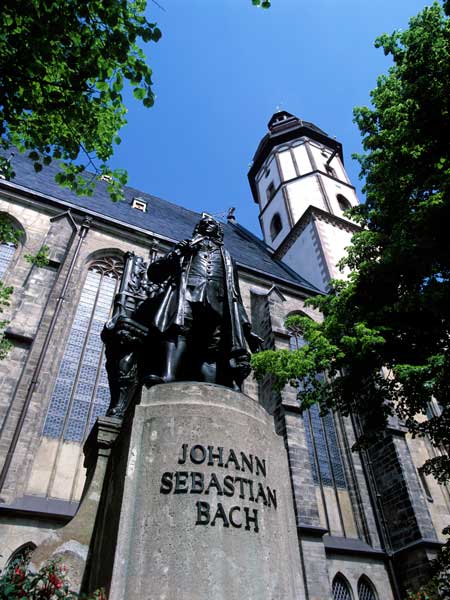
Bach’s tomb is in the church’s sanctuary, and just a short walk away is the Bach Museum with multimedia stations to hear his magnificent music.
A “Treasure Chamber” containing original manuscripts and other rarities.
Besides St. Thomas, Bach also served as cantor at Leipzig’s St. Nicholas Church, in more recent years associated with the 1989 “Peaceful Revolution” that helped bring an end to the communist German Democratic Republic.
With new music regularly required at both churches, Bach produced a prodigious output during his tenure in Leipzig, including several cantata series, the St. John and St. Matthew Passion, the Christmas Oratorio, and the Art of the Fugue.
Also on the Trail are a monument to Richard Wagner, born in Leipzig and still known locally as somewhat of a “bad boy”; the Grassi Museum of Musical Instruments; the Schumann House.
The Oldest Coffee House in Germany
The Zum Arabishchen Coffe Baum, the oldest coffee house in Germany and the meeting point for centuries for the city’s musicians and writers.

My personal favorite was the Mendelssohn House. Even if you have to wait in line, it’s worth it to visit the “Effectorium” where you can stand and conduct a virtual orchestra playing Mendelssohn’s music.
You decide which piece will be played and whether it will be performed on modern or historic instruments.
Want a crescendo in the strings? Or does the brass section need a bit toned down? You’re the conductor, so you decide!
All year long, concerts of live music abound in Leipzig. The Bach Festival in June is especially popular with more than 100 events across the city.
We heard a concert of organ and choral music in St. Thomas Church itself — with the composer’s tomb just steps away, it was almost as if he were listening along with us.
But plentiful other celebrations include festivals for Wagner and Schumann, a festival of a capella vocal music, and even the largest “Goth” festival in the world.
This year marks the 275th anniversary of Leipzig’s famed Gewandhaus Orchestra, which had its beginnings in a trade hall associated with garment merchants, and it’s also the 325th birthday of Leipzig Opera.
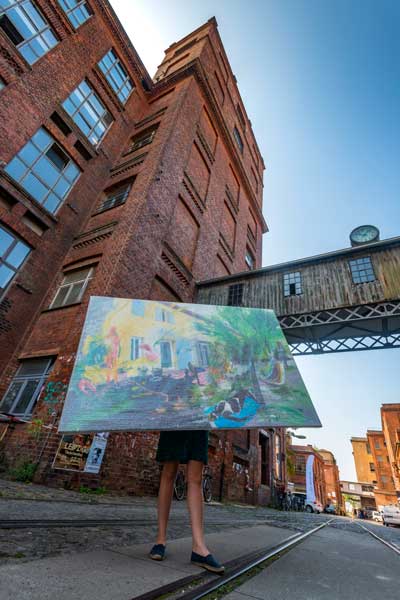
But by no means is Leipzig living on its laurels. It still has a vibrant arts scene, and in fact, you may well hear the city referred to as “the new Berlin”.
Because the creative class is being lured by the hundreds to Leipzig, not to Germany’s capital, due to Leipzig’s cheaper cost of living and über-hip vibe.
Ground Zero for this arts scene is the city’s Plagwitz neighborhood, where a must-see is the “Alte Spinnerei,” once the largest cotton mill factory in continental Europe.
Nowadays, the 23 massive brick buildings on a 25-acre site, complete with towering smokestacks, have been transformed into a vibrant artists’ colony where more than a hundred artists in every medium have set up studio space.
There are also a dozen galleries featuring rotating exhibits of contemporary art in the cavernous rooms of the former industrial complex, an art library, a cinema, and a café.
You may well rub elbows with internationally known artist Neo Rauch during your visit to the Alte Spinnerei. The famed member of the “New Leipzig School” was the first to set up his studio there.
Our Guide from Columbus
But I couldn’t have been more surprised by the person I ran into during my own visit. Our guide, Elizabeth Gerdeman, opened our tour by announcing she was from Columbus, Ohio, the city where I live!
She had spent a year on an artist’s exchange in Dresden, Columbus’s sister city, and was so impressed with Saxony’s arts scene that she returned to be part of the creative ferment in Leipzig.
We visited Elizabeth’s studio and some of the exhibits in the huge galleries, all the while listening to her infectious stories about the exciting arts scene in Leipzig.
This was our last stop before heading out for other sites in Saxony, and it definitely made me loathe to leave. I resolved to make a point to return someday soon to the “New Berlin.”
More Destinations in Saxony
Outside Saxony’s big cities, you’ll want to visit to Meissen with its famous hilltop castle, Germany’s oldest, and the adjacent cathedral.
But don’t miss a visit to the world-famous Meissen State Porcelain Manufactory where artisans can be watched creating and hand-painting exquisite tableware, figurines, and other decorative objects.
Elsewhere in the facility, a grand exhibition hall showcases 300 years of Meissen porcelain with dazzling examples in room after breathtaking room complete with grand staircases and ceilings with elaborate murals.
Of course, there are also opportunities to shop, and there’s even a café where you can dine on Meissen porcelain.
Torgau is another small, unspoiled city with 500 Renaissance and Gothic structures clustered in the city center.
The most spectacular is Hartenfels Castle with a stunning outdoor spiral staircase that puzzles architects to this day how it’s supported. Nearby is the small chapel that historians deem as the first Protestant church.
On my next trip to Saxony, I’d return to any of these places in a heartbeat, but I’d also head for the town of Görlitz on the Polish border with 4,000 buildings of many architectural styles.
So well-known, it has come to be known as “Görliwood.” I’d also head to the Erzgebirge Mountains, famed for its artisans creating Nutcrackers and other Christmas ornaments.
There are also castles galore to explore throughout the entire state.
If You Go to Saxony, Germany
The website www.saxonytourism.com gives overviews of the tourism potential for the entire state of Saxony. For more specific views of Dresden and Leipzig, go to www.dresden.de/en/tourism/tourism.php and https://languages.leipzig.travel/en/Home_110.html.
Author Bio: Ohio-based travel writer Rich Warren travels the U.S. and the world looking for offbeat and off-the-beaten-path stories. He is a graduate of the Elf School of Reykjavik and can tell you what the Amish wear to the beach in Florida.
- 6 Reasons to Visit Portland, Maine (+ Travel Tips) - April 18, 2024
- Cruising with Discovery Princess on the Mexican Riviera - March 30, 2024
- La Paz, Mexico: Pearl on the Sea of Cortez - February 26, 2024
